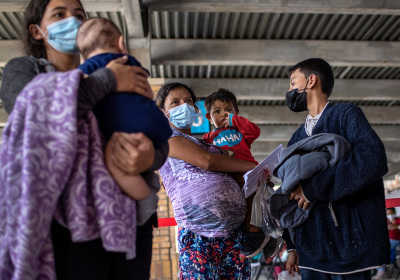Hunger is on our doorstep. The time to act is now
Recently we have seen migrants from Central America, particularly unaccompanied children, cross the U.S. border in record numbers. Experts say recent hurricanes and the socio-economic impacts of COVID-19 are fueling this latest surge.

Josue Sosa, who works in a semi-rural community of Honduras, confirms this. Over the past year he has watched as COVID-19 swept through his town, bringing lockdowns that closed borders and halted travel. He saw produce like tomatoes rotting on the vine, locally owned small businesses close, and factory jobs disappear. Most still have not returned.
Then came the hurricanes – one after another, washing away bridges, flooding homes, and blowing off roofs. With each new hardship, conversations around town began to shift as well.
“Talk of migration has increased,” he says. “Now it’s 80 to 90 percent of the topic of conversation. Sometimes it seems like the only thing I hear people talk about is leaving – not only migrating out of Honduras, but also moving within the country.”
World Food Programme (WFP) analysis has found that the number of people facing hunger in Honduras and Guatemala has quadrupled in the past two years. And as hunger has increased in Guatemala, Honduras, El Salvador and Nicaragua, more and more families are thinking about migrating. Around 15 percent of people surveyed in Central America by WFP say they had plans to migrate in 2021 – that is 6 million people. There is the potential for a massive wave of migration as families seek out what any parent would – food and hope. No parent wants to see their child go hungry.
But perhaps even more concerning are the countries where we are not yet hearing about COVID’s secondary impacts on food and hunger. WFP estimates that worldwide, 270 million people are now at risk of starvation due to a deadly mix of conflict, climate shocks and COVID. The threat of famine is looming – in the Democratic Republic of the Congo, Madagascar, South Sudan, Yemen and elsewhere. In many more countries, rates of food insecurity are sky-rocketing.
Josue was one of many in Central America thinking about migration in his 20s, until interventions came in the form of support, connection with his local church, help with his education, and practical advice for how to thrive at home. He has been able to build a small business growing and selling green peppers and plantains. And now he works with World Vision, providing the same types of assistance that offered him a better future and kept him home with his family. It is a ripple effect that we have seen providing hope for thousands of families to build a future in their own country. Since the pandemic hit, World Vision has been providing food rations for families and loans for store owners to be able to re-open.
We know from our organizations’ extensive experience that if families have food security, safety and some degree of hope, they do not want to leave home. We need to ensure there is funding to meet the needs of communities before people begin leaving home, before the declarations of famine, and before children begin paying the lifelong price of a lack of food – such as stunting or harm to their cognitive development. Where funding exists, a safety net of programs can be put in place which give people hope at home.
In fact, the return on investment is startling. We can feed a child for a dollar a week, versus spending $3,500-4,000 a week caring for them once they arrive in the US. So let’s feed people at home and help them to thrive in their own communities – it is not only the right thing to do, it is the smart thing to do.
For Josue, there is immense satisfaction in that. He tells his story to anyone who will listen. “There’s nothing better than to study or to build something of your own,” he says proudly.
David Beasley is the Executive Director of the United Nation's World Food Programme. Edgar Sandoval Sr. is the president and CEO of World Vision.



























